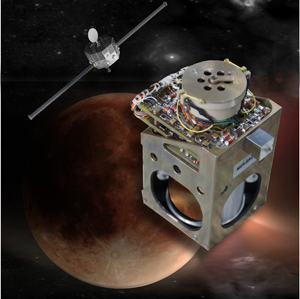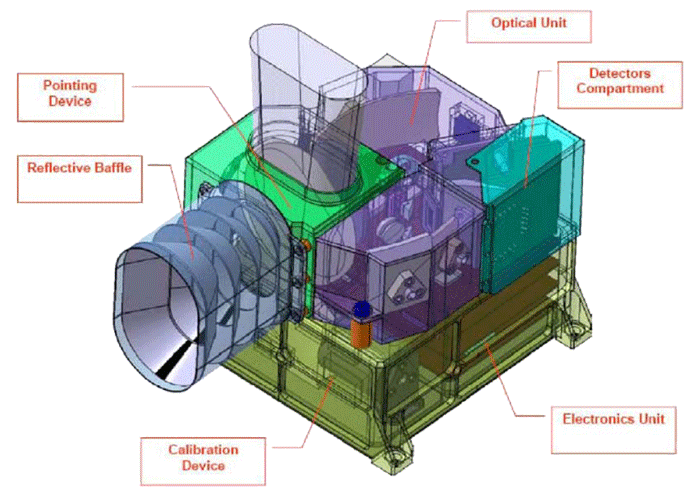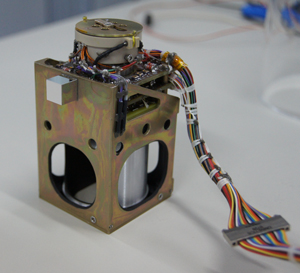
![]() BepiColombo was launched on 20 October 2018 from Europe's spaceport at Kourou, French Guiana on an Ariane 5. The spacecraft will have a seven-year interplanetary cruise to Mercury using solar-electric propulsion (ion thrusters) and gravity assists from Earth, Venus and eventual gravity capture at Mercury. Now the Launch and Early Orbit Phase (LEOP) has been started and it will end on the fourth day after launch. Then the commissioning activities will be completed. The commissioning of the spacecraft (MPO and MTM) includes deployment of the medium- and high-gain antennas and the magnetometer boom, release of the electric propulsion system thruster-pointing mechanisms, MPO payload and MMO activation and functional checkout, as far as this is possible in the MCS configuration.
BepiColombo was launched on 20 October 2018 from Europe's spaceport at Kourou, French Guiana on an Ariane 5. The spacecraft will have a seven-year interplanetary cruise to Mercury using solar-electric propulsion (ion thrusters) and gravity assists from Earth, Venus and eventual gravity capture at Mercury. Now the Launch and Early Orbit Phase (LEOP) has been started and it will end on the fourth day after launch. Then the commissioning activities will be completed. The commissioning of the spacecraft (MPO and MTM) includes deployment of the medium- and high-gain antennas and the magnetometer boom, release of the electric propulsion system thruster-pointing mechanisms, MPO payload and MMO activation and functional checkout, as far as this is possible in the MCS configuration.
![]() The Principal Investigator (PI) of MERTIS (MErcury Radiometer and Thermal Infrared Spectrometer)is Prof.Dr Harald Hiesinger from the Institut für Planetologie (IfP) in Münster, Germany. The IfP was closely cooperating with two DLR centers located in Berlin: DLR-PF and DLR-OS. A number of sub-contractors has signed to do additional work - they were responsible for various studies at the current stage of development.
The Principal Investigator (PI) of MERTIS (MErcury Radiometer and Thermal Infrared Spectrometer)is Prof.Dr Harald Hiesinger from the Institut für Planetologie (IfP) in Münster, Germany. The IfP was closely cooperating with two DLR centers located in Berlin: DLR-PF and DLR-OS. A number of sub-contractors has signed to do additional work - they were responsible for various studies at the current stage of development.
![]() One of the sub-contractor was SRC. The "Pointing Unit" subsystem (acronym MPOI) for orienting of a measurement direction of the MERTIS for spectral measurements of the Mercury surface and calibration has been developed in Remote Sensing Department. The MPOI as one of the spectrometer modules is situated in front of MERTIS to orient the optical entrance of the instrument to 4 different targets sequentially. These targets are the Mercury surface and deep space as well as two black body of 300 and 700 K. Besides strong needs for miniaturization environmental conditions are key for design details: operational temperature range –30°C to +70°C, random vibration loads around 40g rms and high level of radiation. The required performance is characterized with a pointing accuracy 0.8 arcmin for the main targets and a pointing mirror flatness of better than 0.4 μm for sufficient wave front quality.
One of the sub-contractor was SRC. The "Pointing Unit" subsystem (acronym MPOI) for orienting of a measurement direction of the MERTIS for spectral measurements of the Mercury surface and calibration has been developed in Remote Sensing Department. The MPOI as one of the spectrometer modules is situated in front of MERTIS to orient the optical entrance of the instrument to 4 different targets sequentially. These targets are the Mercury surface and deep space as well as two black body of 300 and 700 K. Besides strong needs for miniaturization environmental conditions are key for design details: operational temperature range –30°C to +70°C, random vibration loads around 40g rms and high level of radiation. The required performance is characterized with a pointing accuracy 0.8 arcmin for the main targets and a pointing mirror flatness of better than 0.4 μm for sufficient wave front quality.

![]() The flight model of the BepiColombo Mercury Magnetospheric Orbiter and the Mercury Planetary Orbiter have arrived at ESA's European Space Research and Technology Centre (ESTEC) in the Netherlands in 2015. The two spacecrafts joined the Mercury Transfer Module, the Magnetospheric Orbiter Sunshield and Interface Structure in the spacecraft stack for the functional and integration tests of the whole flight system.
The flight model of the BepiColombo Mercury Magnetospheric Orbiter and the Mercury Planetary Orbiter have arrived at ESA's European Space Research and Technology Centre (ESTEC) in the Netherlands in 2015. The two spacecrafts joined the Mercury Transfer Module, the Magnetospheric Orbiter Sunshield and Interface Structure in the spacecraft stack for the functional and integration tests of the whole flight system.
![]() The main last activity in CBK was conducting tests of Spare Flight Model (SFM). All tests of SFM MPOI were carried out in reported period. We carried out additional functional tests with new EGSE equipped in the new s/w according to requirements delivered by DLR and we prepared End Item Data Package of SFM. The SFM was delivered to the consortium of MERTIS instrument in 2014.
The main last activity in CBK was conducting tests of Spare Flight Model (SFM). All tests of SFM MPOI were carried out in reported period. We carried out additional functional tests with new EGSE equipped in the new s/w according to requirements delivered by DLR and we prepared End Item Data Package of SFM. The SFM was delivered to the consortium of MERTIS instrument in 2014.

![]() In 2012 the Flight Model was redesigned to fulfill the radiation requirements for magnetic sensors. Qualification test at dummy FM and full acceptance tests were performed on FM. Spare Flight Model was assembled and tested as well.
In 2012 the Flight Model was redesigned to fulfill the radiation requirements for magnetic sensors. Qualification test at dummy FM and full acceptance tests were performed on FM. Spare Flight Model was assembled and tested as well.
![]() In 2011 QM and FM models were manufactured and tested. Refurbishment of the FM model was implemented in temperature sensors and Hall sensors.
In 2011 QM and FM models were manufactured and tested. Refurbishment of the FM model was implemented in temperature sensors and Hall sensors.
![]() Design, manufacturing and tests pre-qualification models PQM#1 and PQM#2 models were developed in 2010. Also new VHDL software for controlling MPOI and new software for EGSE have been implemented.
Design, manufacturing and tests pre-qualification models PQM#1 and PQM#2 models were developed in 2010. Also new VHDL software for controlling MPOI and new software for EGSE have been implemented.
![]() Design, manufacturing, assembling and full tests of Development Model DM#2 were performed in 2009.
Design, manufacturing, assembling and full tests of Development Model DM#2 were performed in 2009.
![]() The laboratory model was design and manufactured, functional and thermal tests were carried out using EGSE developed for this model. Basing on results of tests a new development model (DM) was design and and manufactured. This model was delivered to DLR in 2008.
The laboratory model was design and manufactured, functional and thermal tests were carried out using EGSE developed for this model. Basing on results of tests a new development model (DM) was design and and manufactured. This model was delivered to DLR in 2008.
![]() The preliminary phase of MERTIS development has been started in 2007. The requirements for instrument and its description will be published in the following documents: Instrument Requirement Review and Preliminary Design Review.
The preliminary phase of MERTIS development has been started in 2007. The requirements for instrument and its description will be published in the following documents: Instrument Requirement Review and Preliminary Design Review.